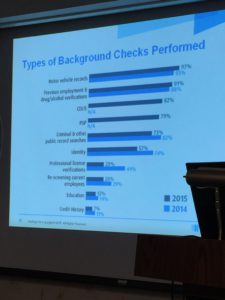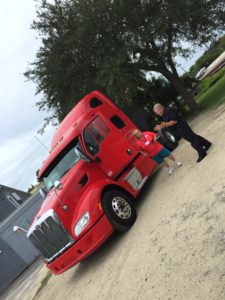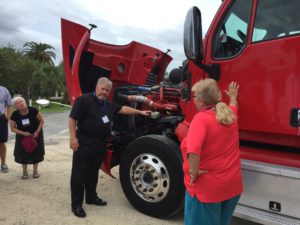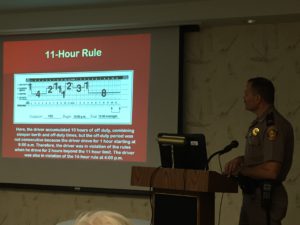NATSA 2015 Meeting
This year’s NATSA meeting was A LOT of fun and a lot of learning. Presentations included; Driver Qualification Files, DVIR’s, Florida’s DataQ process, ELDs, FMCSA, Factoring, URS, and more.
Driver Qualification Files
After NATSA President Dave Gray welcomed us all to the 29th annual NATSA Conference, Joyce Daake got us started with the first presentation on Driver Qualification Files. She is well-spoken and took a complicated topic and made it easy to understand as well as entertaining.
What’s Driver Qualification?
Motor carriers are responsible for the safe operation of commercial motor vehicles on the roads. Before a newly hired driver goes on the road, he needs to be qualified by the company who hired him. It would be helpful if a company had a check list they could follow to make sure they get everything done completely and correctly. Often it’s not only the necessary tests a carrier needs, but also the new driver’s written authorization to do those tests.
Daake offered a helpful example. She elected someone sitting in the front row to be her “secretary” and put her in charge of DQ files which is often exactly what happens in a Carrier’s office. A random employee is simply chosen to do this work, and not given any training. We joked about the back and forth in this process and her point was well made.
In the end, it enforced the fact that making sure all the drivers on the road are safe is a team effort. Doctors, HR, police officers, and even other drivers help make the qualification. That’s a lot to keep track of and you need a strong system in place to help.
HireRight
Justin Reed form HireRight came to share a bit about his company. The most interesting part of it for me was his discussion regarding the driver shortage. Some of the top business challenges his organization has identified were right where you would expect them to be: finding, retaining and developing the right people.
With the Baby-boomer generation retiring, the wants and needs of your average trucker are shifting. Gone are the days where the freedom of the open road was the number one draw. Drivers now want more time at home and better benefits just to name a few. Well, some drivers do. There are still some cowboys out there who love the open road and live happily out of their trucks.


It’s going to be interesting to watch the industry change over the next several decades.
DVIR
Dixie Burbank spoke with us about DVIR’s. Her focus was on protecting the driver and the carrier in the event of an accident and lawsuit.
What’s a DVIR?
A Driver Vehicle Inspection Report is a two part inspection process where the driver walks around his truck both before he starts and after he finishes driving for the day and checks things like tire pressure, breaks, load balance and more to ensure the truck is safe to drive. Each driver should have a written Post Trip Inspection noting aspects of the truck that are in need maintenance soon, or that all is well as a protection from litigation in the case of an accident.
In the event of a crash if a driver does not have a valid DVIR, then it is up to the officer on site to determine whether your vehicle was safe to drive. That means that taking that 30 minutes at the beginning and ending of each day to inspect the truck before it hits the road protects the driver, the company he works for, and everybody else on the road too.
There’s a lot of resistance to DVIR’s because they take a lot of time to do, and most drivers just want to drive. That’s what they signed up for and a necessary aspect when driving. Burbank recommends inviting the driver’s families to a meeting where pre- and post-trip inspections are discussed. That will get the truckers family on board helping to encourage and remind the driver to do his twice daily inspections. They want to keep their beloved truck driver safe and that helps keep everyone safe.
After Burbank explained the basics we went outside to a real truck and Gilles Dillare and Bonnie Logue walked us through an inspection.


It was good fun, and it took is at least the 30 min recommended by Burbank.
Data Q’s and Log Auditing
Lieutenant Bobby Cates of the Florida Highway Patrol came to discuss Data Q’s and Log Book Auditing with us. Data Q is the process a carrier goes through when they need an item on their SAFERSYS.org profile reviewed for accuracy or correction.
Lieutenant Cates is the first to review these cases when they are submitted to Data Q. He’s looking to be sure the law was correctly applied, and he appreciates any evidence you can include with your dispute to help him.
VOLPECenter can be reached by phone at 877-688-2984
FMCSA Technical Support can be reached by phone at 703-280-4001
He also shared with us the training he puts his offers through on log books. How to spot a violation, and how to understand the various rules.


ELD – Electronic Logging Device
Soona Lee from EROAD gave us a presentation on ELDs or Electronic Logging Devices. By definition, an ELD is a device or technology that automatically records a drivers driving time, and facilitates the accurate recording of the drivers Hours of Service (HOS) to keep specific requirements. This is not necessarily a physical device. With the FMCSA’s final ruling expected any day now, compliance will soon become mandatory and every truck will need an ELD.
Important Contact People
That’s only the tip of the iceberg. If you want more details, feel free to request my notes by emailing support@2290Tax.com. We highly encourage you attend next year’s meeting! There are only a few other important details I want to be sure you have today. Contact People!
Tim Cotter of FMCSA
Tim.Cotter@dot.gov
(717)614-4067
Jeff Loftus of FMCSA
Jeff.Loftus@dot.gov
(202)385-2363
Written By Casey Bullard
